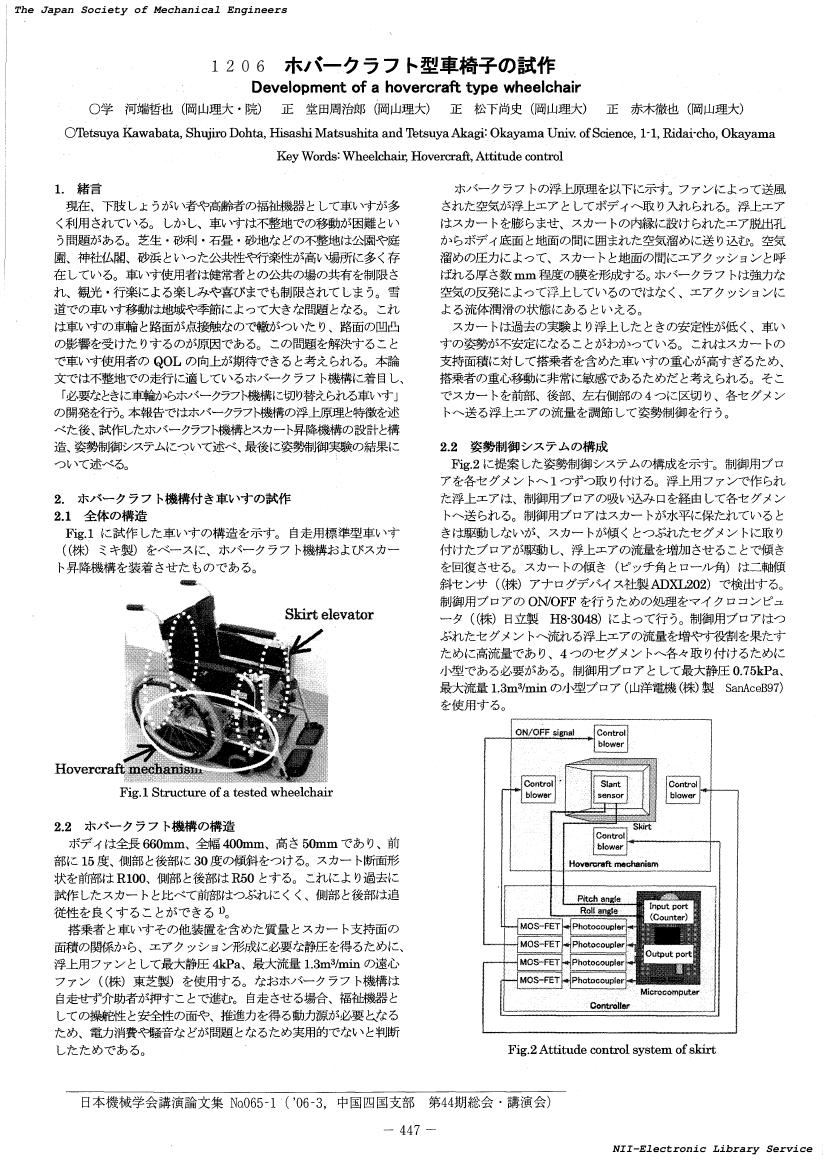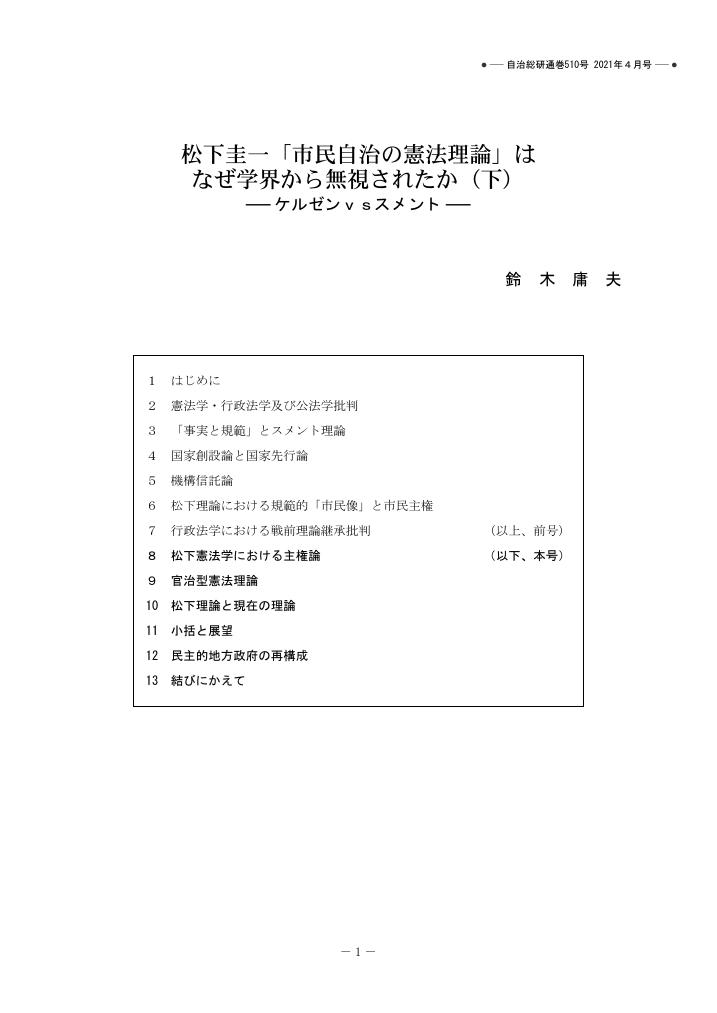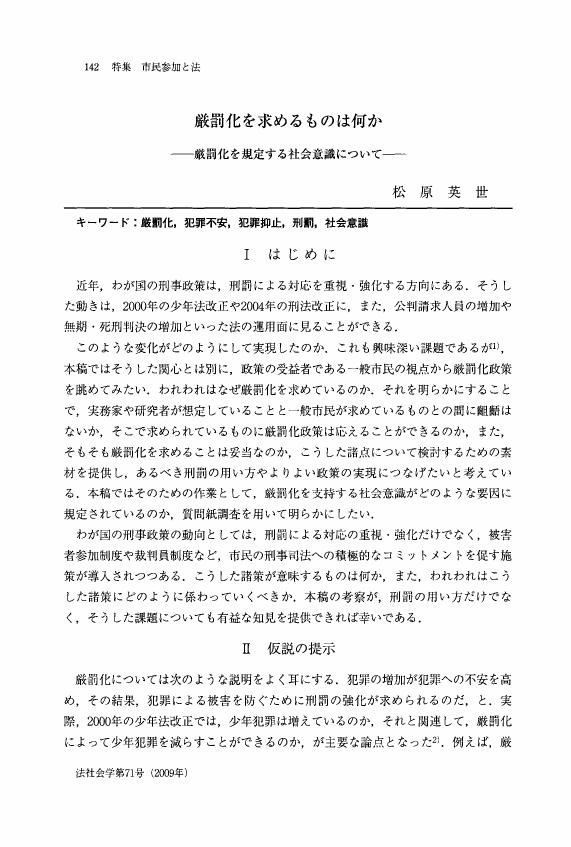5 0 0 0 OA 市街高架線東京万世橋間建設紀要
- 著者
- 鉄道省東京改良事務所 編
- 出版者
- 鉄道省東京改良事務所
- 巻号頁・発行日
- 1920
5 0 0 0 OA 1206 ホバークラフト型車椅子の試作(ロボティクス・メカトロニクスVI)
- 著者
- 河端 哲也 堂田 周治郎 松下 尚史 赤木 徹也
- 出版者
- 一般社団法人 日本機械学会
- 雑誌
- 中国四国支部総会・講演会 講演論文集 2006.44 (ISSN:24242764)
- 巻号頁・発行日
- pp.447-448, 2006-02-23 (Released:2017-06-19)
5 0 0 0 OA 解剖学的観察を用いた内転筋群における股関節回旋作用の検討
- 著者
- 平野 和宏 木下 一雄 河合 良訓 安保 雅博
- 出版者
- 公益社団法人 日本理学療法士協会
- 雑誌
- 理学療法学Supplement Vol.41 Suppl. No.2 (第49回日本理学療法学術大会 抄録集)
- 巻号頁・発行日
- pp.1413, 2014 (Released:2014-05-09)
【目的】近年,機能解剖学に関する報告が認められるも,深層筋における報告は少なく,その知見は十分とは言い難い。内転筋群は大きな筋群であるが,筋電図を用いた大内転筋の機能についての報告は散見されるも,それ以外の筋に関しては報告がほとんど認められず,その機能については明確になっていない。骨格筋の機能を理解するには,解剖学的観察は有効な手段である。その利点は,関節角度の変化に伴う筋の短縮や伸張の度合いを3次元的に観察できるため,筋の作用が理解可能な点である。本研究では,解剖学的観察所見を基に,恥骨筋,長内転筋,短内転筋(以下;3筋)の回旋作用について検討することを目的とした。【方法】当大学解剖学講座に提供された,肉眼的に股関節に明らかな障害のない献体3体5肢(男性2名,女性1名,73歳~78歳)を用いた。献体の固定方法は,厚生労働大臣の承認する死体解剖資格取得者により,アルコール36%,グリセリン13,5%などを含む混合固定液を大腿動脈から注入し固定した。骨盤は恥骨結合および仙骨を切断し,下肢は膝関節から切断,表皮及び結合組織,脈管系,表層筋を除去して3筋を剖出した実験標本を作製した。作製した実験標本を用いて股関節中間位における3筋の3次元的な走行を確認し,股関節中間位からの他動的な股関節内旋・外旋運動に伴う筋の伸張・短縮を観察した。尚,解剖学的観察においては,死体解剖資格を有する指導者のもと実施した。【倫理的配慮】本研究は,当学の倫理委員会の承認を得て施行した。【結果】各筋の起始停止として,恥骨筋は恥骨上枝から起始し,小転子のすぐ遠位の恥骨筋線に停止,長内転筋は恥骨稜の下部から起始し,大腿骨粗線に停止,短内転筋は恥骨下枝から起始し,恥骨筋線および大腿骨粗線近位部に停止しており,3筋ともに恥骨から起始し,大腿骨の後面へ停止していた。走行として3筋は内旋の回転軸と直交に近い走行であった。3筋は恥骨から起始し,大腿骨の後面へ停止していることから,観察のみでは外旋作用を持つと考えられたが,股関節中間位から他動的に内旋すると3筋は短縮し,外旋すると伸張した。頭側から尾側方向にて起始停止の位置関係を観察すると,内旋で起始停止は近づき,外旋で起始停止は離れた。また,内旋時に3筋は大腿骨に巻き込まれるように短縮することが確認された。さらに,股関節内旋には内転が伴い,内転を伴わない内旋を行うと,頚部と臼蓋がimpingementを起こしやすいことが確認された。【考察】現在,身体運動への個々の骨格筋の寄与は,徒手筋力検査法(Manual Muscle Testing;以下MMT)における知識が一般的である。しかしながら,骨格筋は3次元的な走行を持っているため,関節角度の変化やOpen Kinetic Chain(開放運動連鎖 以下;OKC)とClosed Kinetic Chain(閉鎖運動連鎖運動 以下;CKC)の違いによっても関節に及ぼす機能は変化する場合がある。MMTにおける股関節内旋筋は中殿筋,小殿筋,大腿筋膜張筋とされている。関節の回転トルクを発揮する場合,関節の回転軸に直交する筋走行ならば強い回転トルクを発揮できるが,回転軸に平行する筋走行では回転トルクは発揮できない。中殿筋,小殿筋,大腿筋膜張筋は股関節屈曲位であれば強い内旋トルクを発揮するのには有利な走行であるが,股関節中間位では回転軸に平行する走行となるため,内旋トルクを発揮するには不利な形態である。一方,3筋は内旋の回転軸と直交に近い走行であるため,内旋トルクを発揮するのに有利な形態であり,今回の結果からも他動的な内旋時に3筋の短縮が確認された。以上の事から,3筋は股関節中間位における内旋の機能があると考える。しかし,内旋時に3筋は大腿骨に巻き込まれるように短縮することが確認されており,大腿骨側が動くOKCよりは,骨盤側が動くCKCのときに内旋に作用しやすいと考えられる。今回,股関節中間位からの他動的な内旋を行ったところ,内転を伴いながら内旋することが確認された。肩関節であれば骨頭から直接長軸方向に上腕骨が伸びているため,軸回転としての内外旋が可能であるが,股関節は頚体角と大腿骨頚部が存在することや,骨頭と臼蓋の関係からも内転を伴わない内旋を行うと,頚部と臼蓋がimpingementを起こしやすくなることを確認しており,これらのことから生理的な動きとしては内転を伴いながら内旋するものと考える。この複合運動は,実際の動作としてはknee inを連想させるものであった。【理学療法学研究としての意義】今回,その機能が明確とは言えない恥骨筋,長内転筋,短内転筋の3筋の股関節回旋作用について,解剖学的観察を用いて検討した。骨格筋の機能を理解することは,精度の高い理学療法介入の一助になると考えられ,理学療法学研究としての意義があると考える。
- 著者
- 鈴木 庸夫
- 出版者
- 公益財団法人 地方自治総合研究所
- 雑誌
- 自治総研 (ISSN:09102744)
- 巻号頁・発行日
- vol.47, no.510, pp.1-23, 2021 (Released:2021-04-26)
- 著者
- 鈴木 庸夫
- 出版者
- 公益財団法人 地方自治総合研究所
- 雑誌
- 自治総研 (ISSN:09102744)
- 巻号頁・発行日
- vol.47, no.509, pp.1-22, 2021 (Released:2021-03-30)
5 0 0 0 OA 道教・民間信仰における元帥神の変容
5 0 0 0 OA 本邦における炭酸泉の歴史的概観(1)
- 著者
- 中村昭
- 出版者
- 人工炭酸泉研究会
- 雑誌
- 人工炭酸泉研究会雑誌
- 巻号頁・発行日
- vol.2, no.1, 1999-03
5 0 0 0 OA 「ソフトロボティクス」特集について
- 著者
- 新山 龍馬 田原 健二
- 出版者
- 一般社団法人 日本ロボット学会
- 雑誌
- 日本ロボット学会誌 (ISSN:02891824)
- 巻号頁・発行日
- vol.37, no.1, pp.2-3, 2019 (Released:2019-01-15)
5 0 0 0 OA 厳罰化を求めるものは何か
- 著者
- 松原 英世
- 出版者
- 日本法社会学会
- 雑誌
- 法社会学 (ISSN:04376161)
- 巻号頁・発行日
- vol.2009, no.71, pp.142-158, 2009 (Released:2017-01-31)
5 0 0 0 OA ネコにおけるヒトから向けられた視線の認識
- 著者
- 子安 ひかり 永澤 美保
- 出版者
- THE JAPANESE SOCIETY FOR ANIMAL PSYCHOLOGY
- 雑誌
- 動物心理学研究 (ISSN:09168419)
- 巻号頁・発行日
- vol.69, no.1, pp.27-34, 2019 (Released:2019-10-02)
- 参考文献数
- 23
- 被引用文献数
- 5
For animals living in groups such as some primates including humans and wolves, it is important to recognize the gaze of others and change their behavior accordingly. Dogs, which have a common ancestor with wolves, gained the ability to read human's gaze even though they are different species in the process of domestication. Although cats are originally solitary animals, cats sharing their living space with humans are frequently observed in modern days. Recent study showed that cats are likely to be able to detect the human gaze directed to themselves. In this study, we examined whether cats are able to recognize the human gaze and whether to change their behavior according to it. We investigated whether cats show different behaviors depending on the direction of the human gaze. As a result, when humans looked at the cats, the time which the cats looked back at the humans was shorter, regardless of familiarity and distance with the humans and the social situation. Also, when humans look at cats when the distance between individuals is short, the eyeblink frequency of cats increases. From these facts, it was shown that cats could recognize directedgaze from humans and change their behavior accordingly.
5 0 0 0 OA 戦後スターリン期トルクメニスタンにおける運河建設計画とアラル海問題
- 著者
- 地田 徹朗
- 出版者
- 北海道大学スラブ研究センター
- 雑誌
- スラヴ研究 (ISSN:05626579)
- 巻号頁・発行日
- vol.56, pp.1-36, 2009
This article investigates three grandiose canal construction projects in Turkmenistan during the post-war Stalin period and their relationship with the Aral Sea problem. These three projects are the "Karakum Canal," the "Major (Glavnyi) Turkmen Canal" and the "Diversion of Siberian Rivers" projects. In order to illustrate these projects' logical structures and their mutual contrarieties, made by central authorities, republican leaders, scientists in the center and technical experts in the construction field, the author approaches these projects from three points of view: 1. political history (both central and republican), 2. history of science and technology (geography, hydrology and hydraulic engineering) and 3. regional studies (Central Asia, especially Turkmenistan). It is not this article's purpose to "attribute" the Aral Sea problem to the USSR's water policy's negative impacts. Rather, the author tries to "depoliticize" these topics. The go signal for the "Karakum Canal" project was given by a resolution of the Soviet Union's Council of Ministers (CM) on 21 July 1947 (that is, before the beginning of "Stalin's Nature Transformation Plan," which started in 1948), although its initial concept dates back to the beginning of the twentieth century (G. Sazonov's idea). The First Project Document, edited by A. Boltenkov, hydraulic engineer in the Turkmen SSR, was approved on 25 January 1947 at the USSR Gosplan's Scientific-Technical Expert Commission, which described the Karakum canal as contributing to expeditiously expanding the irrigated lands for cotton production in the southeastern Turkmenistan oasis along the Murgab and Tedzhen rivers. This document referred only to the "future prospect" of this canal's elongation to Ashgabat and further. Turkmenistan (not "Turkmen") specialists actively participated in the preliminary work of drafting the document. Turkmen leaders called for the early realization of this "quick-impact" project, but the central Gosplan authorities denounced their requests, accusing them of holding up another construction project of the Tedzhen reservoir, which would eventually be completed in 1950, when the "Great Communist Construction" slogan and the start of the "Major Turkmen Canal" project were announced. As a result, the Karakum Canal project fell back to the second plan, whose beginning the Turkmens had to await until 1954, that is, the next year after Stalin's death. The prototype of the "Major Turkmen Canal" project dates back to 1893, when imperial army officer A. I. Glukhovskoi presented his original plan to route some volume of Amu-Darya's water to the Caspian Sea through the Uzboi riverbed's remnants, although an idea of this kind also existed during Peter the Great's reign. The resolution of the USSR's CM on this project was adopted on 11 September 1950 "without" the Project Document, as part of "Stalin's Nature Transformation Plan" and the "Great Communist Construction" projects (which included the famous "Volga-Don Canal"). The former "Plan," the core concept of the construction of "communism" itself (as well as the "Great Communist Construction") in the post-war period, became the theoretical background of this large-scale canal project, which had to be finished by 1957, and as a result of which 1,300,000 ha of newly irrigated land (mainly around the Amu-Darya delta and southwestern Turkmenistan) and 7 million ha of new pasture land (in the Karakum desert) should have been cultivated by the final stage. Both Moscow-Leningrad based geographers (I. P. Gerasimov, V. A. Obruchev, V. V. Tsinzerling, etc.) and on-site hydraulic engineers (V. S. Eristov, chief engineer of the Construction Administration "Sredazgidrostroi," etc.) enthusiastically supported this project, despite some clashes of viewpoints about the "canal route." The former favored the Western-Uzboi route, but the latter proposed the southbound route, going through the Karakum desert via an artificial canal. The latter variant was adopted at last. Turkmen authorities also assisted with this project, but their role was limited to providing indirect supports for constructors. This project ended abruptly on 25 March 1953 at the initiative of L. P. Beria immediately upon Stalin's death. The discussion about the "Diversion of Siberian Rivers" project also began in connection with the above-mentioned "Nature Transformation Plan." This project's antecedent is also very old, going back to Y. Demchenko's idea in 1871, which the Imperial Geographical Society's members laughingly dismissed at that time. The idea came back to life in the 1920s after the Bolshevik Revolution, and M. M. Davydov, hydraulic engineer of the Hydroelectric Power Station Designating Institute "Gidroenergoproekt," published his plan in 1949, which proposed the large-scale diversion and multipurpose use (that is, not only for agricultural development and climatic change, but for river transportation and hydroelectric power generation) of the Obi and Yenisei waters in Western Siberia and Central Asia. Davydov clearly claimed that this canal would "liquidate deserts" in Central Asia. In 1950, the other variant of this project by hydraulic engineer A. A. Shul'ga, showed that this canal increased vapor circulation in the atmosphere by around 12-20%, which created additional water flow in rivers in the respective regions. These plans were not approved at that time, but became the basis of further full-fledged examination from the 1960s onward. Finally, scholars' outlooks on the future Aral Sea problem were examined in the context of grandiose canal construction projects. First of all, the "nature transformists" had reached a consensus that plain water should be used for irrigation as much as possible, rather than being fed uselessly into the saline Aral Sea. Accordingly, hydrologists figured out how many meters the Aral Sea would fall as a result of the construction of two grandiose canals in Turkmenistan. The Karakum Canal up to the Tedzhen oasis would have lowered the Aral Sea by about 2.5 meters, according to the Project Document. Leningrad-based hydrologist B. D. Zaikov estimated that the Aral Sea would have fallen by about 11.7 meters if the Major Turkmen Canal had taken 600 cubic meters per second, although this fall would have been fastest during the first 20 years, slowing considerably thereafter. In sum, about a 14.2 meter drawdown was foreseen during the two canals' planning stages. Knowing well these predictions, some Soviet geographers (B. A. Fedorovich, N. N. Mikhailov, etc.) already had related the canal projects in the Aral Sea basin with the diversion of Siberian water to Central Asia as a prescription for the Aral Sea's shrinkage. It is well-known that the Aral Sea started to scale down after 1960 in conjunction with sluicing water into the Karakum canal, but Central Asian authorities were not frustrated until the Aral Sea problem reached a critical stage, because the diversion of a great amount of Siberian water held great promise for them. Central authorities around Stalin upheld the "Nature Transformation Plan" and the "Great Communist Construction" as an ideologically true national credo, which should have contributed to the post-war rebuilding and communist construction. Turkmenistan's leaders were inclined more to the economically "quick-impact" Karakum Canal project than to the more "ideological" Major Turkmen Canal project, regardless of their acceptance of the latter project itself. Fervently supporting the "Nature Transformation Plan," geographers and on-site hydraulic engineers tried to vindicate their own viewpoints on the Major Turkmen Canal, which could be described as a leadership struggle around this project. Some hydraulic engineers attempted to ride the wind, propounding the grandiose "Diversion of Siberian Rivers" project in the context of the "Nature Transformation Plan." As such, various actors' various motives were intricately intertwined with these grandiose canal construction projects, forming a specific historical stage emblematic of the post-war Stalin period.
5 0 0 0 IR 日本語の量的テキスト分析
- 著者
- カタリナック エイミー 渡辺 耕平
- 出版者
- 早稲田大学高等研究所
- 雑誌
- 早稲田大学高等研究所紀要 (ISSN:18835163)
- 巻号頁・発行日
- no.11, pp.133-143, 2019-03-15
5 0 0 0 OA 大日本史料
- 著者
- 東京帝国大学文学部史料編纂所 編
- 出版者
- 東京帝国大学
- 巻号頁・発行日
- vol.第4編之7,
5 0 0 0 OA Measurement of urinary mesotocin in large-billed crows by enzyme-linked immunosorbent assay
- 著者
- Akiko SEGUCHI Kazutaka MOGI Ei-ichi IZAWA
- 出版者
- JAPANESE SOCIETY OF VETERINARY SCIENCE
- 雑誌
- Journal of Veterinary Medical Science (ISSN:09167250)
- 巻号頁・発行日
- vol.84, no.4, pp.520-524, 2022 (Released:2022-04-13)
- 参考文献数
- 30
- 被引用文献数
- 2
Mesotocin (MT) is an avian homologue of oxytocin (OT). Behavioral pharmacological studies in birds have suggested the involvement of MT in socially affiliative behavior. However, investigations of peripheral MT levels associated with social behavior are lacking because non-invasive methods to measure surrogate plasma MT have yet to be established. This study aimed to measure urinary MT in crows using a commercially available OT enzyme-linked immunosorbent assay kit. Urine samples were collected after intravenous injection of MT and centrifuged to separate urine and fecal components. We found that urinary MT was significantly elevated 15–30 min after MT injection. These results validate our method for the use of urine samples for the measurement of peripheral MT levels in crows.
5 0 0 0 OA 欧米に於ける日本史研究の現状と動向
- 著者
- 今谷 明
- 出版者
- 国際日本文化研究センター
- 雑誌
- 日本研究 (ISSN:09150900)
- 巻号頁・発行日
- vol.35, pp.201-214, 2007-05-21
アメリカ、フランス、オランダ、ドイツ各国に於ける日本史研究の現状と特色をスケッチしたもの。研究者数、研究機関(大学など)とも圧倒的にアメリカが多い。ここ十年余の期間の顕著な特色は、各国の研究水準が大幅にアップし、殆どの研究者が、翻訳資料でなく、日本語のナマの資料を用いて研究を行い、論文を作成していることで、日本人の研究者と比して遜色ないのみか、医史学など一部の分野では日本の研究レベルを凌駕しているところもある。
- 著者
- 井上 和哉 佐藤 健二 横光 健吾 嶋 大樹 齋藤 順一 竹林 由武 熊野 宏昭
- 出版者
- 一般社団法人 日本認知・行動療法学会
- 雑誌
- 認知行動療法研究 (ISSN:24339075)
- 巻号頁・発行日
- vol.44, no.2, pp.101-113, 2018-05-31 (Released:2019-04-05)
- 参考文献数
- 34
- 被引用文献数
- 2
本研究では、スピーチ場面に対するウィリングネスの生起には、価値の意識化のみで十分であるか、それとも、価値の意識化の前に創造的絶望を付加することが必要であるかを検討した。社交不安傾向者の学生22名を創造的絶望+価値の意識化群、価値の意識化のみ群、統制群の3群に割り当て、介入効果の比較を行った。価値の意識化のみ群、統制群には創造的絶望を実施せず、回避行動が一時的に有効であることを話し合った。介入から一週間後のスピーチ課題時に、創造的絶望+価値の意識化群、価値の意識化のみ群には価値を意識させ、統制群には価値を感じないものを意識させた。その結果、創造的絶望+価値の意識化群のスピーチ場面に対する前向き度が統制群より増加した可能性が示された。また、創造的絶望+価値の意識化群のスピーチ場面から回避したい度合いが他群より減少した可能性が示された。
- 著者
- 清水 安夫 煙山 千尋 尼崎 光洋 Yasuo SHIMIZU Chihiro KEMURIYAMA Mitsuhiro AMAZAKI
- 雑誌
- 桜美林論考. 自然科学・総合科学研究 = The journal of J. F. Oberlin University. Natural and applied sciences (ISSN:21850712)
- 巻号頁・発行日
- vol.1, pp.81-95, 2010-03-01
5 0 0 0 笑いの発生メカニズム
- 著者
- 柴原 直樹
- 出版者
- 近畿医療福祉大学
- 雑誌
- 近畿福祉大学紀要 (ISSN:13461672)
- 巻号頁・発行日
- vol.7, no.1, pp.1-11, 2006-06-15
A great Greek philosopher, Aristotle once said that laughing is a nature of human beings. Since then, agreat number of scholars such as philosophers, linguists, psychologists, literati, and writers have tried toexamine the mechanisms of laughter from their unique viewpoints, although a satisfactory explanation of thecause of laughter has not yet been made. In this paper, I first presented the classification of laughing intoseveral types such as a pleasurable laughter, a social smile, and so on, from phylogenetic and ontogeneticperspectives. Then, I overviewed various interpretations of the cause of laughter from philosophical,linguistic, and psychoanalytic viewpoints, presenting concrete examples of wit, humors and jokes,whichleads to an investigation of how and why people could laugh. Finally, the mechanisms of a smile andlaughter an a physiological level were discussed in terms of the brain systems and its relation to facialexpressions.
5 0 0 0 OA Lightning Bubbles Caused by Upward Reflectivity Pulses above Precipitation Cores of a Thundercloud
- 著者
- Yukie Moroda Kazuhisa Tsuboki Shinsuke Satoh Katsuhiro Nakagawa Tomoo Ushio Hiroshi Kikuchi
- 出版者
- Meteorological Society of Japan
- 雑誌
- SOLA (ISSN:13496476)
- 巻号頁・発行日
- pp.2022-018, (Released:2022-04-15)
- 被引用文献数
- 1
A rapid rise of the lightning activity center in the upper part of a cloud is called a lightning bubble (LB). It remains unclear how LBs occur in thunderstorm clouds. Recently, high-spatiotemporal resolution data obtained by a phased array weather radar enabled observation of temporal changes in the three-dimensional structure of precipitation cores in a precipitation cell. To understand the mechanism by which LBs occur, we examined the relationship between the time-evolution of precipitation cores and the flash initiation points.After a precipitation core developed in an isolated thundercloud, the top height of the core reached its highest altitude and then started to descend. Meanwhile, the echo tops above the core continued to rise, which is termed an upward reflectivity pulse (URP). Over an hour, nine URPs were successively observed in the thundercloud. The average tracking period of the URPs was 3.9 minutes. Flash initiation points appeared near the highest points of the URPs and continued to rise with time. These observational results suggest that URPs cause LBs by enhancing the electric field, via the separation of graupel and ice crystals near the highest points of ascending URPs.
5 0 0 0 OA 16世紀「価格革命」論の検証
- 著者
- 平山 健二郎 Kenjiro Hirayama
- 雑誌
- 経済学論究 (ISSN:02868032)
- 巻号頁・発行日
- vol.58, no.3, pp.207-225, 2004-12-31



